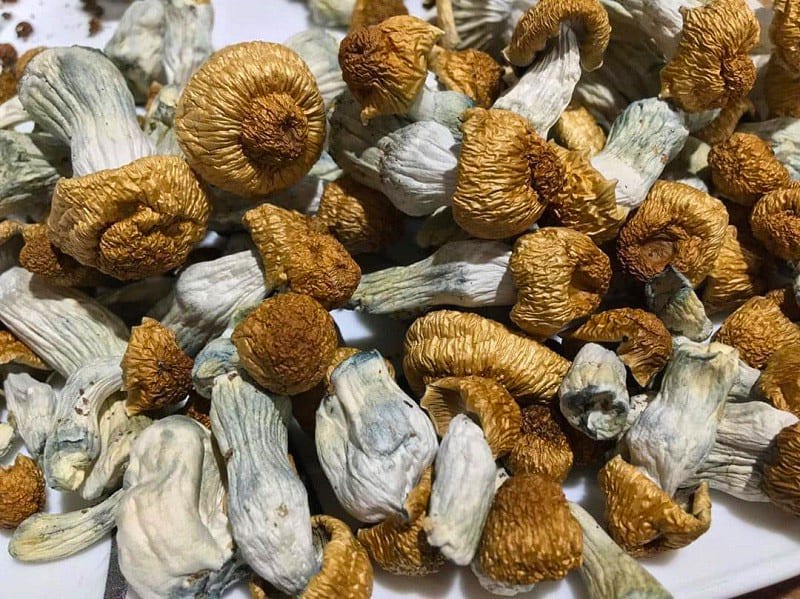Psilocybin Mushrooms /saɪləˈsaɪbɪn ˈmʌʃˌɹuːm/ are naturally grown and produced psychedelics that can induce the short-term effects of mixed sensory experiences and long-term psychological symptoms.
Psilocybin and Psilocin are the two chemicals that give hallucinogenic mushrooms their psychoactive characteristic. Psilocybin is the main psychoactive ingredient in magic mushrooms. It is responsible for heightened emotional and sensory reactions. Psilocin is a metabolite of psilocybin. Another hallucinogenic ingredients found in the mushrooms are phenethylamine, a compound that acts as a stimulant of the central nervous system.
Upon ingestion, its physiological effects are similar to that of LSD - there is a change of perception, mood, thought and emotion which can shift the typical visual and auditory senses. Colors can change shape, ripple or have a sense of movement. Music can be more sonorous and intense. Emotional effects are also often experienced. Extremely happy, negative and anxious thoughts can resurface and hallucinations suggest that a large dose was taken.
The history of this fungi goes back to the Mesoamerican period where they were initially used for healing purposes that evolved to psychedelic drugs in the 20th century.
Physical appearance
Psilocybe Genus
Psilocybin and Psilocin fungi that belong to the Psilocybe, Panaeolus and Copelandia genuses have more than 50 species. They are divided into subspecies grown in different countries. For example, Australian psilocybin mushrooms are known as Golden tops and Blue meanies whereas those in the UK are Liberty caps and Fly agarics.
These are generally white, grey, brown or tan and small. They can easily be mistaken for the poisonous or common store kind. They have long, slender stems that have dark gills on the underside of their caps. Psilocybin Mushrooms that go through the drying process have a reddish brown color that is similar to rust and some areas can be off-white.
Throughout the subspecies, appearances differ with each mushroom. Liberty caps have a distinct earthy taste and a rubber-like texture in between one’s fingers. Fly agarics have toadstools with red and white spots. Shrooms with an active psilocybe ingredient can turn blue or green when they are cut.
Psychedelic Drug
Psilocybin mushrooms
can be harvested and sold dried and whole or powdered. Psilocybin content is higher in the caps than in the stems. It is recommended that either the caps or the stems be used to avoid an overdose. Synthetic psilocybin powder from the mushrooms produces a white, crystalline powder. They are packed and transported as tablets or capsules. Liquid psilocin and psilocybin can be mixed or stored with other solvents.
What are the other names of psilocybin mushrooms?
- Hallucinogenic mushrooms
- Psilocybin
- Psilocyn
- Boomers
- Caps
- Cubes
- Liberty caps
- Little smoke
- Magic mushrooms
- Mexican mushrooms
- Mushrooms
- Musk
- Sacred mushrooms
- Sherm
- Shrooms
- Silly cybin
- Silly putty
- Simple simon
Combination names
- Fungus Delight (Mushroom powder mixed in fruit juice)
- Flower Flipping/Hippie Flip (Mushrooms with ecstasy)
Uses
This substance is mainly used for recreation. In most instances, they are often eaten raw, boiled with tea and sometimes combined with substances that have a subdued effect like cannabis. The mushrooms are often boiled with tea, sugar and other ingredients to hide their bitter flavor.
Pure synthetic psilocybin, commercially known as Indocybin®, was produced for experimental and psychotherapeutic purposes during the 1960s. Their side effects became more prevalent and they were immediately phased out.
Psilocybin mushrooms as drugs can potentially be a cure for certain mental conditions. Specific minimal doses can minimize suicidal thoughts and psychological distress on healthy adults. In a National Survey of Health and Drug use conducted from 2008 to 2012, results show that the psychedelic ingredient found in psilocybin can lessen tendencies of suicidal thinking and planning, depressed moods, alcohol dependence, tobacco cessation and personality behaviors like obsessive compulsive and anxiety disorders.
In the past few years, a growing number of studies using human volunteers have begun to explore the possible therapeutic benefits of drugs such as psilocybin, LSD, DMT, MDMA, ibogaine and ketamine. These studies are looking at psilocybin and other hallucinogens to treat a number of otherwise intractable psychiatric disorders, including chronic depression, post-traumatic stress disorder, and drug or alcohol dependency.
Strength/Doses
The potency of psilocybin mushrooms depends on the species, origin, growth environment and harvest time. Active ingredients in dried processed mushrooms is 10 times higher than fresh ones because the latter retains more water. Also expect that shrooms growing in the wild have more consistent potency when harvesting in large quantities.
A typical recreational dose ranges from 1 to 5 g of mushroom depending on the potency of the species. Dried mushrooms typically have about 0.2 to 0.4 percent of psilocybin with traces of psilocin. Manufacturing of the drug allowed for the potency to be diluted with other substances like LSD and phencyclidine or replacing hallucinogenic mushrooms with store-bought ones.
How long does the drug stay in the body?
Psilocybin is converted to psilocin by the gastrointestinal enzymes on an average of 20 to 40 minutes after ingestion. Hallucinogenic effects activate within 30 minutes and peaks after an hour and a half. It takes a duration of 4 to 6 hours until these effects leave the system.
The body’s metabolism removes the psychoactive substances in 24 hours. For regular users who are planning to cleanse, effects can remain for three days. It is expected that 95 percent of psilocybin leaves the body after 13 hours and more than 95 percent for psilocin after four hours.
Standardized drug tests do not test for psilocybin or psilocin as they do common substances like cocaine, marijuana, and certain opioids. Certain drug testing companies offer specialized tests when requested so be sure to inquire.
Blood - 13 hours
When finding psilocybin and psilocin in the blood, the result is less definitive. In most cases, the chemicals leave the blood in 13 hours and are detected in tests after 24 hours.
Urine - 1 to 3 days
A study from the Journal of Pharmaceutical and Biomedical Analysis showed positive traces of psilocybin in urine 24 hours after consumption. The compound can stay in the system for 1 up to 3 days.
Hair - 90 days
Despite administering hair tests for hallucinogen abuse, special hair test samples can detect magic mushroom use for 90 days.
The amount of shrooms taken, frequency of use, and potency depending on the kind used are all determining factors of how long the drug lasts in an individual’s system. For some people, it can take a quicker or slower time to metabolize. Higher doses can take time to metabolize and will more likely get a positive result the longer it stays in the body.
Other factors that influence detection are weight, height, race, age, alcohol use, smoking history, health of internal organs (liver or kidney), and other medical conditions.
How one gets addicted and how it is dangerous
Psilocybin mushrooms are not necessarily addicting but it can lead to codependency and psychological disorders that can affect long-term perception and brain function. Typical side effects of hallucinogens are symptoms of Hallucinogen Persisting Perception Disorder like dizziness, flashbacks, possibility of psychosis, paranoia, and panic attacks.
How the drug affects the body (examples of experiences)
Once psilocybin enters the body, it converts to psilocyn by stomach acid and eventually reaches the brain. It then disturbs the interaction of nerve cells and destructs the functioning serotonin, a neurotransmitter that is responsible for brain cognition and psychological processes.
How one reacts to the drug depends on the type of mushroom used, amount of dosage and how it is taken, biological make-up, past drug use and psychological tendencies. Age and weight can also be factors. Psilocybin mushroom effects are variable.
Effects
Short term effects of using Magic Mushrooms happen when they are taken regularly. This happens 20 to 90 minutes after intake:
- Hallucination
- Visual and auditory distortion
- Experiencing trips - change in consciousness and perceptions
- Detachment from reality
- Tremors
- Sleep disturbances
- Blurred vision
- Intense emotions
- Loss of coordination
- Beginning of psychosis or paranoia
- Feeling of floating
Long-term effects - what categorizes as addiction is the pattern of taking the drug that eventually leads to the disruption of a person’s life. Behavioral symptoms include:
- Refusal to cut down mushroom intake
- Having strong urges for mushrooms
- Taking more mushrooms than originally intended
- Giving up daily activities for mushrooms
- Using mushrooms in deep emotional problems
Psychological effects:
- Heightened sensory experiences
- Difficulty focusing and short term attention span
- Synesthesia (sense switching)
- Impaired judgment
- Sense of detachment
- Adverse and intense reactions
Withdrawal symptoms
There are no official withdrawal symptoms for hallucinogenic mushrooms. If any, they are usually difficult to detect or if visible, this suggests that the user has been taking the drug for long periods. Physical side effects for long-term use are:
- Dilated pupils
- Loss of appetite
- Hyperthermia or hypothermia
- Increased blood pressure and heart rate
- Dry Mouth
- Nausea
Psychological withdrawal symptoms include:
- Sleep Disturbances
- Recurring pleasant and unpleasant emotions
- Extreme mood swings
- Panic episodes
- Psychotic breaks
- Speech difficulties
Treatment
Medicines, medical professionals and behavioral therapy are some ways of treating mushroom addiction.
- Medicines - Benzodiazepines are prescribed when expecting a seizure or major agitation. Taking a recommended dose can resume brain activities and repair motor function impairment. It is important to note, however, that these medicines can be addictive if not with a prescription.
- Medical professionals available for this kind of addiction are counselors, psychologists, addiction doctors, addiction clinics, drug detox clinics, or psychiatrists.
- Behavioral therapies include dual diagnosis care, psychotherapy, and social support.





